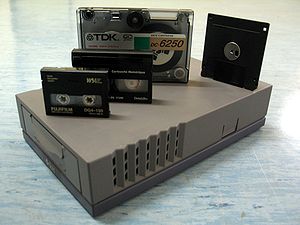
Back Стрымер Byelorussian Стример Bulgarian Unitat de cinta Catalan Pásková jednotka Czech Båndstation Danish Bandlaufwerk German Unidad de cinta Spanish Lindiseade Estonian نوار گردان Persian Nauha-asema Finnish

A tape drive is a data storage device that reads and writes data on a magnetic tape. Magnetic-tape data storage is typically used for offline, archival data storage. Tape media generally has a favorable unit cost and long archival stability.
A tape drive provides sequential access storage, unlike a hard disk drive, which provides direct access storage. A disk drive can move to any position on the disk in a few milliseconds, but a tape drive must physically wind tape between reels to read any one particular piece of data. As a result, tape drives have very large average access times. However, tape drives can stream data very quickly off a tape when the required position has been reached. For example, as of 2017[update] Linear Tape-Open (LTO) supports continuous data transfer rates of up to 360 MB/s, a rate comparable to hard disk drives.